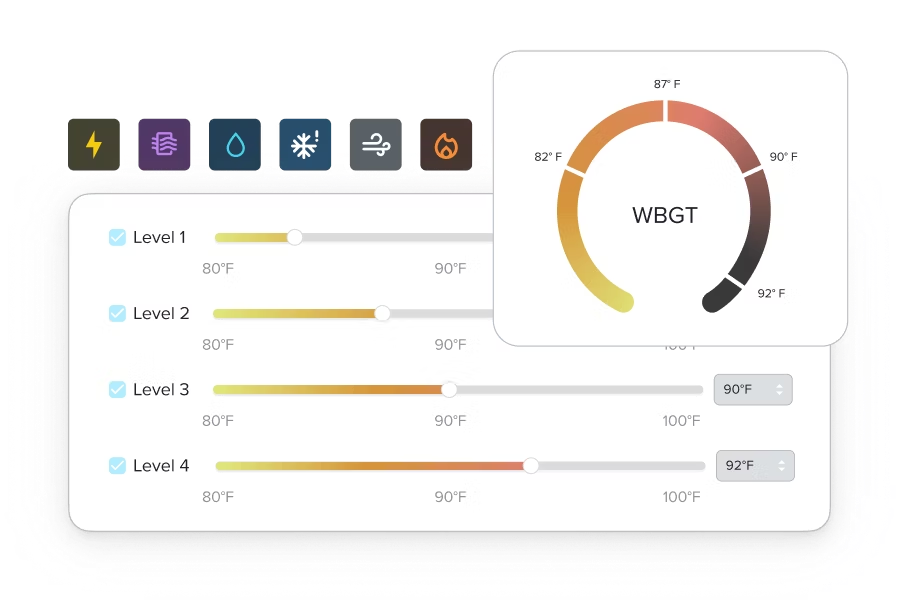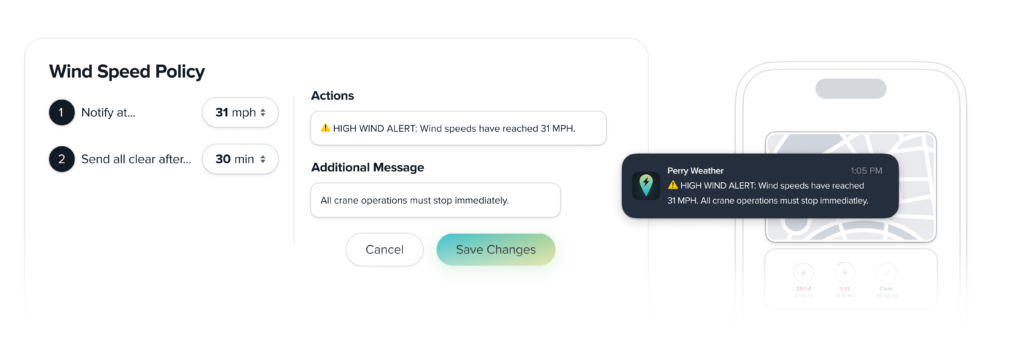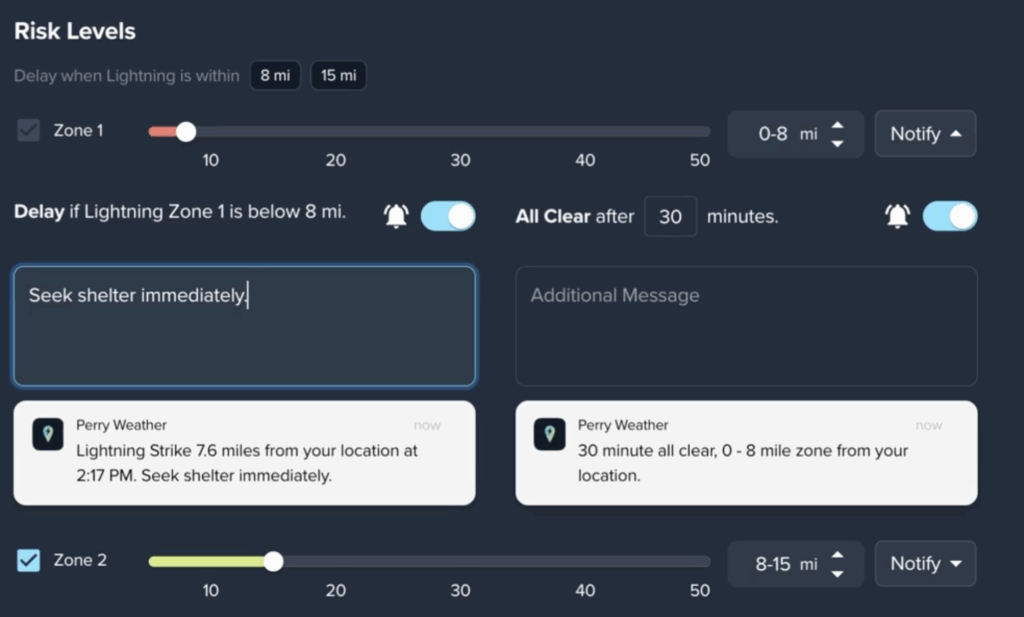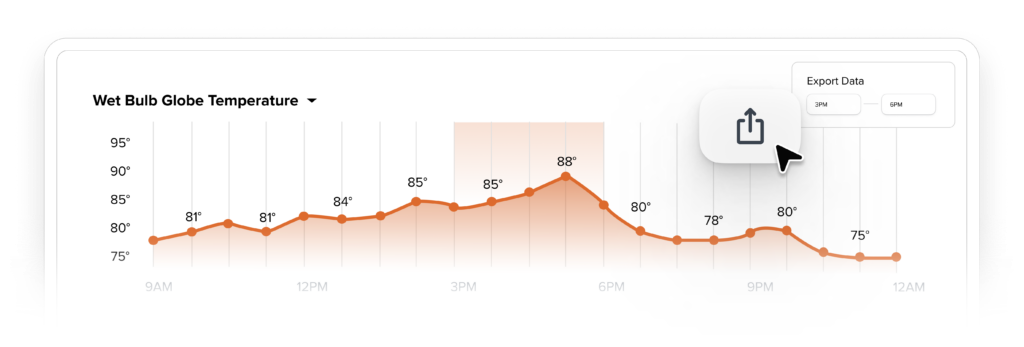Weather policy management shouldn’t feel like herding cats across job sites. One missed lightning alert can delay crews for hours. Disjointed weather rules leave workers exposed.
Yet, many teams still rely on fractured, manual processes: custom lightning zones here, one-off notifications there, leading to missed alerts, safety gaps, and compliance headaches.
Perry Weather’s revamped Policy Management and Historical Reporting consolidates all your policies, automates alerts, and gives you data-driven insights. The result? One dashboard. One source of truth. Total peace of mind.
Why Manual Weather Policies Fail EHS Teams
When policy lives in spreadsheets and siloed apps, EHS managers waste precious time. Delays stack up. But when a storm hits, how do you ensure that plan is followed consistently across every team and every location?
The truth is, manual processes lead to inconsistent rules, delayed reactions, and guesswork.
- Lightning Risks: Each year, the National Weather Service reports about 20 lightning injuries and 10 fatalities nationwide. Every missed alert could cost hours in delay or, worse, lives.
- Heat-Related Fatalities: The Bureau of Labor Statistics found that in 2023, construction workers accounted for 36% of all heat-related occupational deaths in the U.S.
- Financial Impact: Contractors lose an estimated $5,000 per hour of severe weather-related downtime.
- According to a recent survey among construction leaders, 89% say they lose 4–6 hours per week per site, equating to roughly $5 billion in industry-wide downtime.
Imagine juggling five sites, each with its own severe weather thresholds. Each sets its own lightning zone. One uses a 5-mile radius. Another picks 12. That inconsistency isn’t just annoying—it’s dangerous. A unified inclement weather policy can cut those losses and protect your team.
With Perry Weather’s centralized policy management, you get a weather safety platform that:

- Builds consistent, company-wide policies.
- Automates alerts with precise, multi-level thresholds.
- Assigns rules by crew and site.
- Generates compliance reports on autopilot.
This way you can speed up decision-making and improve compliance by meeting OSHA or other policy guidelines without any manual work or spreadsheets. Everything lives in one place, updated in real time.
Explore Perry Weather’s Enhanced Weather Policy Management Platform
Perry Weather’s powerful new Weather Policy Management Platform is built for EHS leaders who need instant clarity, consistent alerts, and actionable insights—without wrestling with spreadsheets or siloed apps.
Unified Lightning Safety Policies

Inconsistent lightning zones cost contractors thousands of dollars each storm. One standardized policy means every crew shelters at the same threshold—no debate, no delays.
With Perry Weather, now admins can define one lightning safety policy that covers every scenario:
- Multiple Radius Rings
- – Define up to three zones in one policy (for example, 8 mi, 15 mi, 25 mi).
- – Each ring triggers a different alert level—your crew always knows how close lightning is.
- Seamless Migration
- – All your admin-configured zones carry over automatically.
- – You don’t lose months of fine-tuning existing settings.
- No More Ad-Hoc Zones
- – Any user-created, non-admin sliders vanish with the update.
- – This ensures every alert follows your standard, not local tweaks.
The result? Every crew follows the same standard. You reduce misfires, cut confusion, and protect workers before the first flash.

Multiple Risk Levels and Thresholds

Whether it’s blistering heat or massive wind gusts, you can create multiple risk variables per policy instead of separate policies for each policy risk:
- Precision Controls
- – Drag sliders for quick adjustments or type exact numeric values for pinpoint accuracy.
- – For variables with mandatory minimum safe values (like WBGT), the system enforces safe defaults.
- Add More Risk Levels
- – By default, set up to three tiers. Click “Add Risk Level” to expand to as many as eight.
- – Perfect for teams that need granular gradations—from “Be Alert” to “Evacuate.”
- Instant Visual Feedback
- – Each risk tier lights up on the gauge with a distinctive color.
- – You see at a glance which thresholds overlap or leave gaps.

The redesigned page makes it easier to add and manage policies across your account. These multi-level thresholds turn raw weather data into clear, actionable stages—so your weather alert policy software drives faster, safer decisions.
Flexible Site- and Team-Based Assignments

No two construction sites operate the same. Assign policies by crew and location to strike the right balance between compliance and on-the-ground flexibility.
Tailor policies by crew and location. With dual assignment modes, you control exactly who sees which policies and when.
- Assign a policy to user groups (e.g., EHS, Site Supervisors) and/or locations (Site A, Site B)
- A policy can be required for one group yet optional at one site.
- Required vs. Optional
- Toggle policies as required or optional for each assignment.
- – Required policies lock settings for assigned groups—no toggling off.
- – Optional policies appear with a simple on/off switch at the location level Local foremen can enable or disable on a per-site basis.
- Custom-Location Handling
- – Temporary or event sites inherit policies as optional by default.
- – You can’t force-lock alerts on pop-up locations, which need on-the-fly flexibility.
- Check the Policy Status and Assignments
- – A clean view shows every group, location, and toggle status in one screen.
- – Filter by policy status or assignment type for quick audits.
Precision in policy assignments removes friction. You ensure compliance where it matters, and flexibility where you need it.
Custom Alerts & All-Clear Timer
Alerts save lives only if they’re clear and timely. Clear instructions and timing keep crews safe and productive.

- Tailored Alert Text
- – Draft custom alert messages for each risk tier—“Seek shelter immediately” or “Move indoors now.”
- – Dynamic previews show exactly how notifications will appear on devices.
- Global Notification Toggles
- – Flip all alerts on or off with a single click.
- – Or drill down to disable only specific risk-level notifications.
- All-Clear Duration
- – Choose how long after conditions subside before sending an all-clear.
- – Default to 30 minutes—or extend to 60 for slow-moving systems.
- Preview & Test
- – Send a test notification to your own device to verify message clarity and timing.
- – No more blind saves—you see and hear exactly what your teams will.
- – Craft custom in-alert messages (e.g., “Seek shelter immediately”).
- – Set your all-clear timer (e.g., 30 minutes) to control alert cadence.
By controlling both the message and timing, you keep crews informed and confident—every alert reinforces your lightning safety policy instead of sowing confusion.

Turn Data into Decisions with Historical Reporting & Exports

Don’t let your weather policy data sit idle. Perry Weather’s Historical reporting tools turn raw alerts into actionable insights that sharpen safety and streamline operations:
Generate Reports with 15-Minute Granularity
- – Exports break down policy-active time into quarter-hour increments.
- – Ideal for pinpointing high-delay periods.
You can choose how often data is collected, with 15-minutes, 30-minutes, 60 minutes, and 24 hours as options for the frequency of historical data collection.
Armed with that intel, you can tweak your lightning safety policy, shift crews, or pre-stage shelter drills before the next heat of summer.
Recurring Report Scheduling

- Weekly or monthly CSVs land in your inbox automatically.
Feed directly into OSHA logs or internal safety dashboards.
Policy-Level Metrics
- See total hours each policy was active by site or crew.
- Identify overused or under-utilized thresholds for fine-tuning.
Interactive Reports
- In-app charts let you filter by date range, policy, or location—no downloads needed.
These detailed historical insights transform weather policy reporting into a strategic tool. You’ll slash downtime, justify budget, and continuously refine your construction weather policy management.

FAQs on Weather Policy Management
What is construction weather policy management?
Construction weather policy management is the process of defining, automating, and reporting weather-safety rules, like lightning or heat thresholds, across all your job sites.
Perry Weather’s construction weather policy management software centralizes all your site-specific safety thresholds: lightning, heat, wind, and more, into one dashboard. It lets EHS managers define multi-ring lightning zones, automate alerts, and generate audit-ready reports. The result is consistent, real-time protection across every job site without spreadsheets or manual updates.
How do I automate construction weather alerts?
With Perry Weather’s software, link your policy thresholds to real-time weather data. Alerts fire automatically based on predefined risk levels.
Why centralize lightning safety policy on job sites?
Consistency prevents confusion. When every crew follows the same zones, you eliminate safety gaps and cut delays.
Can I export compliance data for OSHA?
Yes. Scheduled CSV exports deliver 15-minute policy-active logs straight to your inbox for audits.
Where do custom locations fit?
Custom (temporary) sites inherit optional policies only—they cannot override required alerts.
How do I set up a lightning safety policy for my construction site?
-
Navigate to New Policy → Lightning in the dashboard.
-
Name your policy (e.g., “High-Rise Lightning Safety”).
-
Define up to three radius rings (8 mi, 15 mi, 25 mi) via slider or exact input.
-
Toggle notifications and set your all-clear timer (e.g., 30 min).
-
Assign the policy to crews or locations as required or optional.
-
Save and watch real-time visual feedback—your multi-ring lightning policy is live in under three minutes.
How do I assign policies to specific crews and sites?
Perry Weather offers dual assignment modes:
-
User Groups: Assign policies to EHS teams, supervisors, or subcontractor crews.
-
Locations: Apply policies at the job-site level—main sites or pop-up/mobile locations.
You can mark a policy as required (locked for assigned groups) or optional (local foremen toggle on/off). An Assignment Dashboard provides a clean audit view of who’s covered where.
Real-World Case Study: Holder Construction’s Project Red
Holder Construction tackled a massive 161-acre site with 500–700 workers on the clock daily. The project sat in central Texas, where summer temperatures routinely topped 100°F.
Challenge: Multiple weather threats loomed. Lightning could strike without warning. Heat stress sidelined crews on scorching afternoons. High winds and sudden storms forced frequent work stoppages.
EHS teams made constant manual calls to pause or resume work. That left room for human error—and costly delays.
Highlights:
“It is very accurate and that has also been a key factor in reducing the amount of heat illnesses on site.”
- Unified Lightning Policy: A single, multi-ring alert system replaced five different site-specific rings. Now everyone shelters when lightning enters the 8-, 15-, or 25-mile zone—no confusion.
- On-Site WBGT Monitoring: Portable wet-bulb globe temperature sensors captured real-time heat risk for every crew. When WBGT climbed above safe thresholds on 45 days this project’s first season, alerts triggered automatically.
Your Blueprint for Safer, Smarter Job Sites
A single, centralized lightning safety policy does more than cut downtime. It keeps your crews safe, your audits clean, and your bottom line healthy. With Perry Weather’s streamlined dashboard, you get:

Consistency Across Sites
– A single lightning safety policy with precise, multi-tier risk levels.
– Crews everywhere follow the same rules—no more site-by-site variability.
Instant, Actionable Automated Alerts
– Custom in-alert messages and an all-clear timer ensure teams know exactly when to shelter and when to resume work.
Streamlined Compliance & Reporting
– 15-minute exports and interactive charts for OSHA logs and safety reviews.
– Recurring CSV exports feed directly into OSHA logs, safety audits, and your EHS dashboard—audit-ready with no extra effort.
Significant Downtime Reduction
– Industry data shows contractors lose $5,000/hour to severe weather delays.
– Centralized policies have driven up to a 40% drop in downtime for top firms like Holder Construction.
Stop wrestling with spreadsheets and siloed apps. Give your EHS team one source of truth. Turn severe weather from a liability into a managed risk.
Your Next Steps as an EHS Manager
- Start a Free Trial: Experience Perry Weather’s weather safety policy tool firsthand, with a 14-day free trial—no credit card required.
- Download the Guide: Grab our “Construction Weather Safety Report” for a breakdown of how extreme heat is reshaping the construction industry.
With Perry Weather’s centralized approach to weather alert policy software, you’ll save time, safeguard your teams, and protect your bottom line—rain, shine, or lightning.










